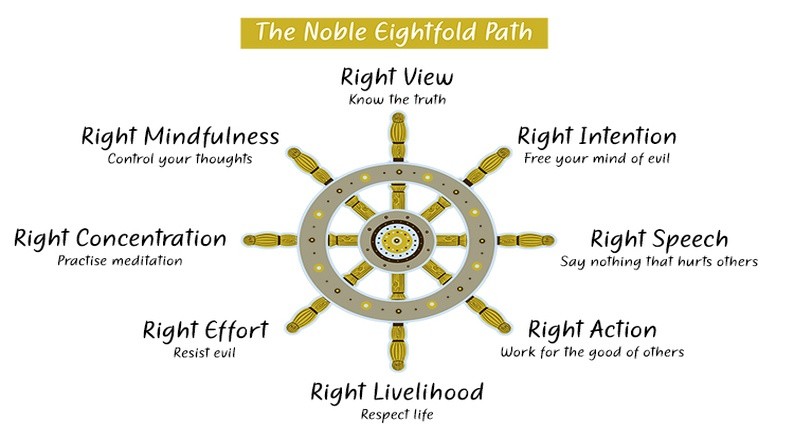The Noble Eightfold Path
The Noble Eightfold Path is the translation of Pali words- “ariya aṭṭhaṅgika magga”. In Sanskrit, it is said as “āryāṣṭāṅgamārga”. This is also called the eightfold Aryan path. It is the path taught by Buddha preceding liberation from samsara, the cycle of birth and death, which is known as nirvana. The eight noble paths are as follows-
1. Sammā ditthi i.e. Right Understanding
There should be a clear understanding to accept something. This is also known as Right Perspective or Right View. One should develop the right view for everything and every situation. See the truth as it is, view the reality of everything as it exists. Misunderstanding, confusion, illusion, or deluded thinking keep creating miseries in life. One has to come out of that negativity. Never follow any path with blind beliefs. Understand the truth as it is, experience the truth as it is which will take to the liberation. Right view is subdivided into Mundane view and Supermundane view.
a) Mundane Right View
knowing fruits of good and bad behavior, which will bring merits and support for better rebirth in the field of Samsara.
b) Supermundane Right View
This is a world- transcending, the true perspective of Karma (Action) and rebirth as given in the “Arya Satya” ie four noble truth for complete enlightenment and liberation from dukkha, all types of miseries.
Mundane and Super-mundane right view accept the following Principles:
a) Karma: Each and every physical, vocal action and mental action has karmic consequences which impact the type of rebirths and realms an entity get in.
b) Three Trace of existence: The world and its elements are momentary (anicca), an origin of misery (dukkha), and deficits the self (anatta).
c) The “Four Noble Truths” and “Noble eightfold path” are appliances for developing knowledge and terminating suffering.
2. Sammā san̄kappa i.e. Right Intention
The attitude must be positive. One should go ahead with the right determination. Right resolve gives the power to do the right work. One should make a commitment of right intention. A good intention guides life to a good path.
3. Sammā vācā i.e. Right Speech
One should speak the truth by being honest. Unnecessary gossip is not good. Slander and abusive speech should be avoided. A civilized and sweet speech soothes everyone.
4. Sammā kammanta i.e. Right Action
This is the practice regarding Right Conduct. One’s physical activities should not harmful to others. Peaceful and harmonious behavior abstaining from stealing, killing, etc. comes under Right action.
5. Sammā ājīva i.e. Right Livelihood
Live a harmonious life avoiding wrong deeds. As far as possible the way of life you live should assist others for their progress but your life-style should never be deleterious.
6. Sammā vāyāma i.e. Right Effort
Make an effort to do what is good and wholesome without any expectation, being free from greed and evil. This will prevent the suffering in future.
7. Sammā sati i.e. Right Mindfulness
It’s about awakening consciousness- witnessing breaths; awareness of the body, postures, sensations, feelings; observing thoughts, emotions, and states of mind moment to moment. It teaches to be mindfulness of the dhammas (elements, teaching). For the practice of Sati, it is elucidated as “bare attention”: be constantly observer of what you do, be present-minded all the time. This will awaken awareness of the impermanence and non I of the body. Finally one will experience the five “skandhas” aggregates, the five obstacles, True Realities, and factors of enlightening.
8. Sammā samādhi i.e. Right Concentration
There must be right mental focus must for this awareness. The mind will be one pointedness. This is known as “Ekaggata” in Pali, which further prepares to practice four stages of meditation:
Kayanupasyana- awareness to position of the body like sitting, walking, running, lying, etc.
Vedananupasyana- awareness of the sensation of the body
Chittanupasyana- awareness on states of mind
Dhammanupasyana- awareness of mental elements.
The Buddha depicted the “ariya aṭṭhaṅgika magga” as a means to enlightenment, as a boat for traversing a river. Once one has reached the opposite shore, one no longer needs the boat and can leave it behind. To overcome all the miseries of life and to reach the final goal noble eightfold path is practiced.
Threefold Division
Buddha has made a three basic division for the eightfold path. The three main divisions are “Sila”, “Samadhi” and “Panna”.
“Sila” means moral virtues with the components of –Right Speech, Right Action, and Right Livelihood.
“Samadhi” means meditation with the components of Right Effort, Right Mindfulness, and Right Concentration.
“Panna” means wisdom or insight with the component of Right View and Right Resolve.
If you want to deep dive in to Buddhism, you can read the post related to Buddhism.

